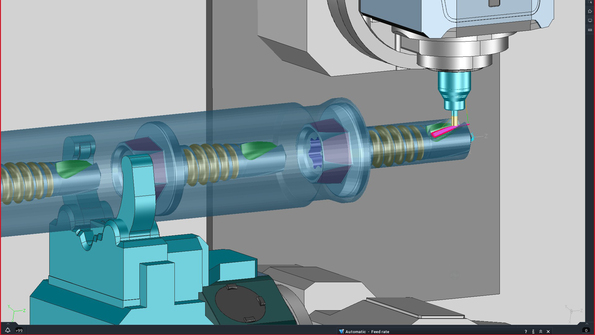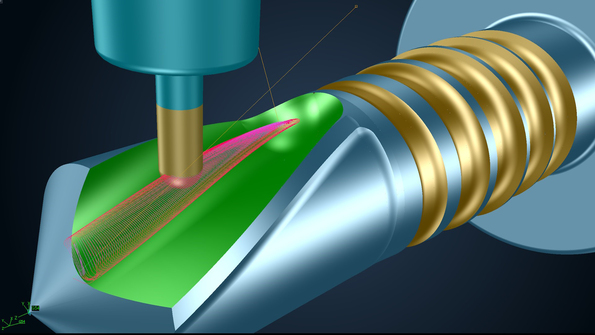-
Software
-
CAM software
- Tebis Automill
- CNC programming
- CNC automation
- CNC simulator
- Multiple setup
- Robotic machining
- CNC drilling
- Deep-hole drilling
- Combined turn-milling
- CNC turning
- Turn-milling
- 2.5D milling
- 3D milling
- 5-axis milling
- Slot milling
- Trimming
- HPC milling
- HFC milling
- Circle-segment cutters
- Sinker EDM
- Wire EDM
- 3D laser cutting
- Laser hardening
- Laser weld cladding
- CAD software
- CAQ software
- MES software
- Products
-
CAM software
- Services
- Consulting
- Sectors
- References
- Company
- News

-

It’s showtime, baby!
Tebis has worked with its partners to create a series of exclusive parts. The team is especially proud of the screw created with DMG MORI – a part that used a CAD/CAM application for end-to-end programming of turning and milling.
The hard factsActual machining took just 4.5 hours and generated a significant quantity of chips with the steel block losing 85% of its initial weight of 100 kg. The dimensions of the finished screw were 200 x 400 mm and was machined in material C45 1.0503 on an NTX3000/3000 using a total of 11 tools.
The most spectacular feats
Transferring the part from the main spindle to the sub spindle is one of the classic challenges in turning. And the combination of turning and milling machines is gaining popularity in the industry, for several good reasons. It offers extensive options, up to and including fully automated 6-sided machining. The part can then be manufactured without manual re-clamping, which reduces throughput time. In addition, the operator’s workload is decreased and additional setup time is eliminated. However, turn-milling machines are also highly complex. The prerequisite for a safe and smooth process is a CAD/CAM application with full control over the machine that includes all positioning movements and automated transfer from the main spindle to the sub spindle.
Tebis excelled here with flexibility and automation. Use of the steady rest can be automatically programmed in the CAM system, so it was possible to simulate this workflow step for the screw and control the steady rest as needed. Positioning, opening and closing of the steady rest and synchronous movement to the sub spindle were all fully automatic; the steady rest didn’t need to be manually set.
Roughing and finishing including radial machining were also quickly, easily and safely performed in Tebis. The software ensured optimal machine dynamics and specifically detected residual stock areas in fillets, corner blendings and cavities, automatically splitting these areas. All this was accomplished with no user intervention.
The highlights in preparing this showpiece included the use of high-performance milling functions from the CAD/CAM system. Because the part features several special geometries, a special roughing cycle designed for shell machining was used for simultaneous milling of the helix with a toroidal tool. This enabled highly efficient use of the tool by moving it offset from the axis of rotation.
A key advantage of automated manufacturing comes from the machine operator's work time being largely decoupled from the operating time of the machine. In the case of this showpiece, the machine operator only had to set up the tools and press the start button before machining.
The actual work was done in advance in offline programming – Tebis simulator technology brought safety and speed together. From the start, the screw was planned end-to-end using so-called "digital twins." These are precise representations of all tools, units like the steady rest, machine and other components, including geometric data and storage of information (e.g., kinematic properties of the machine, tool cutting data for different materials in the tool libraries).
Tebis can fully control all machine operations
 End-to-end machining in a CAD/CAM application (e.g., milling and turning).
End-to-end machining in a CAD/CAM application (e.g., milling and turning). Simple, off-center radial roughing, ensuring a long life for the machine and tool.
Simple, off-center radial roughing, ensuring a long life for the machine and tool.The stunt double: The digital twin
Tebis defines the digital twin as the representation of all existing manufacturing resources and processes in the software. The prerequisites for comprehensive and realistic work with the digital twin require, among other things, that the machines, tools and clamping devices are recorded in all essential detail and the data are continuously maintained. Because the simulation can realistically anticipate reality only if all relevant parameters are reported.
In Tebis, the simulator is fully integrated in the CAD/CAM environment. As a result, the user can perform a valid simulation and collision check at any time in NC programming before post-processing. The most efficient solution is to ultimately check the toolpaths for collisions in the CAM environment and make any necessary corrections before NC output. Most importantly, this procedure is extremely safe, ensuring the best conditions for reduced-personnel and unattended manufacturing (e.g., weekends). As we know, this can only happen if you confirm all machines can continue operating without interruption.
And the award goes to: Every part!
Automation is now a must, in many cases even for lot size 1. And of course, this applies not to just stylish showpieces for tradeshows, but daily production. This is the only way we can convert big investment in precise, high-performance machines into competitive hourly rates. Machining with no operator intervention requires high process stability and corresponding process safety, which is necessary throughout the process, in every operation and at every point in time.



